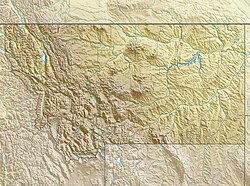Two Medicine Formation
| Two Medicine Formation | |
|---|---|
| Stratigraphic range:Campanian ~ | |
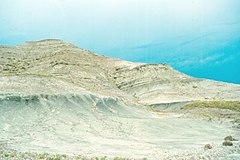 Outcrop of the Two Medicine Formation near "Egg Mountain" in northern Montana | |
| Type | Geological formation |
| Underlies | Bearpaw Shale |
| Overlies | Virgelle Sandstone |
| Thickness | 600 m (2,000 ft) (western portion) |
| Lithology | |
| Primary | Sandstone |
| Location | |
| Coordinates | 48°04′27″N112°17′58″W/ 48.07417°N 112.29944°W |
| Approximate paleocoordinates | 55°18′N77°48′W/ 55.3°N 77.8°W |
| Region | |
| Country | |
| Type section | |
| Named for | Two Medicine River |
| Named by | Stebinger |
| Year defined | 1914 |
TheTwo Medicine Formationis ageological formation,or rock body, in northwesternMontanaand southernAlbertathat was deposited between83.5 ± 0.7 Maand70.6 ± 3.4 Ma(million years ago), duringCampanian(Late Cretaceous) time. It crops out to the east of theRocky MountainOverthrust Belt, and the western portion (about 600 metres or 2,000 feet thick) of this formation is folded and faulted while the eastern part, which thins out into theSweetgrass Arch,is mostly undeformed plains. Below the formation are the nearshore (beach and tidal zone) deposits of theVirgelle Sandstone,and above it is the marineBearpaw Shale.Throughout the Campanian, the Two Medicine Formation was deposited between the western shoreline of theLate Cretaceous Interior Seawayand the eastward advancing margin of theCordilleran Overthrust Belt.The Two Medicine Formation is mostlysandstone,deposited by rivers and deltas.
History of research[edit]
In1913,aUS Geological Surveycrew headed byEugene Stebingerand aUS National Museumcrew headed byCharles Gilmoreworked together to excavate the first dinosaur of the formation.[1]Stebinger was the first to identify the Two Medicine Formation and formally described the first fossils in a scientific paper published in1914.[1]Gilmore returned to the Formation in1928and1935.[1]During this time frame only three species were named and of these onlyStyracosaurus ovatusandEdmontonia rugosidensare still regarded as valid.[1]Barnum Brownprospected the formation in1933,but found nothing significant.[1]Both of their research were interrupted byWorld War II.[1]In1977,Trexler reports findinghadrosaurremains west ofChoteau, Montana.[1]During thenext yearbaby hadrosaurs were discovered.[1]In1979,Horner and Makela referred these hadrosaur bones toMaiasaura peeblesorum.[1]The announcement attracted renewed scientific interest to the formation and many new kinds of dinosaurs were discovered.[2]More nesting sites were discovered later, including the Devil's Coulee site yieldingHypacrosaurus stebingeriin southernAlbertain1987.
Geology[edit]
The loosely consolidated fine grain sediments composing the formation allow for fast plant growth inbadlandareas, limiting the number of exposed outcrops.[3]Paleosols,fluvialdeposits andbentoniticlayers are common in the Two Medicine Formation.[4]
Age[edit]
The Two Medicine Formation spans from 80 to 74 Ma, nearly the entire length of theCampanianstage.[5]The formation has been dated using40Ar/39Ar datingat volcanic ash layers located 10 metres (33 ft) below the top and 105 metres (344 ft) above the base.[5]The deposition of the formation may bediachronous.[6]The Lower Two Medicine dates to lateSantonianto earlyCampaniantimes. The Upper Two Medicine dates to middle-late Campanian times.
Equivalents[edit]
There are several equivalents to the Two Medicine Formation, as with many geologic formations (most of which are named after theirtype locality). The Sweetgrass Arch in Montana divides the Two Medicine from theJudith River Formation,Bearpaw Shale,Claggett Shale,andEagle Sandstone.Across theCanada–United States border,the Two Medicine Formation correlates to theBelly River Groupin southwest Alberta, and thePakowki Formationeastward.
Stratigraphy[edit]
The Two Medicine overlies theVirgelle Sandstone,which formed from the beach sands exposed on northern and western shores of the recedingColorado Sea.[7]A CretaceousInterior Seawaytransgression submerged the area briefly early on in Two Medicine history leaving anomalousparalicsediments and isolatedshalebodies about 100 m above the base of the formation.[8]The Middle portion of the two medicine formation is about 225 m thick, deposited while theClagette Seawas receding and theBearpaw Seatransgressing.[8]This portion is stratigraphically equivalent to theJudith River FormationandJudith River Group.[8]The sediments are mainlybentoniticsiltstonesand mudstones with "occasionalsandstonelenses. "[8]These sediments are thought to be the remains of a coastal plain "far removed" from the interior sea.[8]The upper portion is about one half of the formation.[9]Its sediments are similar to the middle portions but punctuated by extensive red beds andcalichehorizons.[9]The uppermost 80 m were deposited after the inundation of the Judith River equivalent sediments by the Bearpaw Sea.[9]They are thought to have been deposited in only 500,000 years.[9]Bentonitic ash is common in the Two Medicine.[9]To the south extrusive volcanic activity occurred in association with theBoulder Batholithcollectively called theElkhorn Volcanics.[9]
Taphonomy[edit]
Most of the vertebrate fossils are preserved byCaCo3permineralization.[3]This type of preservation preserves high levels of detail, even down to the microscopic level.[3]However, it also leaves specimens vulnerable toweatheringwhen exposed to the surface.[3]
Paleoenvironment[edit]
Climate[edit]

The Two Medicine Formation was deposited in a seasonal, semi-arid climate with possiblerainshadowsfrom the Cordilleran highlands. This region during the Campanian experienced a long dry season and warm temperatures. Lithologies,invertebratefaunas, and plant and pollen data support the above interpretation. The extensive red beds andcalichehorizons of the upper Two Medicine are evidence of at least seasonally arid conditions.[9]Some of the dinosaurs from the formation have been speculated to have shown signs of drought-related death.[9]
Elevation[edit]
A more upland environment existed in the south of the Two Medicine Formation.[8]Streams had a northeasterly flow away from these southwestern uplands.[8]The southern part of the Two medicine formation grades into brackish water siltstone/sandstone series called theHorsethief Formation.[9]The sediments of the Horsethief represent shallower water deposits than the Bearpaw Shale adding further evidence of higher elevation areas existing in the south.[9]
Egg Mountain site[edit]
Egg Mountain, which is nearChoteau, Montana,was discovered in 1977 by Marion Brandvold, owner of the Trex Agate Rock Shop inBynum, Montana,who discovered the bones of juvenile dinosaurs at this site. It is a colonial nesting site on theWillow CreekAnticlinein the Two Medicine Formation that is famous for its fossil eggs ofMaiasaura,which demonstrated for the first time that at least some dinosaurs cared for their young. The eggs were arranged in dug-out earthen nests, each nest about a parent's body length from the next, and baby dinosaurs were also found with skeletons too cartilaginous for them to walk - similar to those ofaltricial(helpless) babybirds.The parent(s) must then have brought food to the young, and there is plant matter in the nests that may be evidence of either this or for incubation of the eggs.Maiasauraalso grew extremely fast, at rates comparable to modern birds. Skeletons ofOrodromeusand skeletons and eggs ofTroodonwere also found at Egg Mountain.
Biostratigraphy[edit]

Mostdinosaur-bearing rock formationsdo not contain multiple distinct faunas at different positions within the formation's stratigraphic column.[10]Usually the lower sediments of a given formation will contain the same kinds of dinosaurs as the upper sediments, or the species composition changes only gradually.[10]However, some researchers had argued that the Two Medicine Formation was an exception, preserving multiple distinct dinosaur faunas.[10]
Later research came to find that the supposedly distinct dinosaur faunas at different levels of the formations were more similar than had been previously thought.[11]While the dinosaur fauna of the lower and middle sections Two Medicine was apparently diverse, the quality of preservation was low and few of these remains can be referred to individual species.[6]The middle Two Medicine is a better source of fossils, but still poor overall. This makes it difficult to argue that these sections of the formation preserve distinct faunas.[11]
The upper portion of the formation is more diverse and preserves better quality fossils.[12]However, many of the taxa that supposedly distinguished it as a separate fauna have since been found in older sediments. In particular,Gryposaurus latidensandHypacrosaurushave been found to coexist withMaiasaura.[11]Further, there are fossil teeth that seem to show the presence of certain taxa are unbroken throughout the whole formation.[11]
Nevertheless, some true changes in faunal composition seem to occur in the upper Two Medicine. The appearance ofMaiasaurain the formation precedes the arrival of a diverse variety of other ornithischians.[11]According to David Trexler, thorough examination of strata found along the Two Medicine River (which exposes the entire upper half of the Two Medicine Formation) indicates that the apparent diversification was a real event rather than a result of preservational biases.[11]
The timeline below follows the stratigraphic chart presented by Horneret al.2001.[13]

Dinosaurs[edit]
Some of the dinosaurs from the formation have been speculated to show signs of drought related death.[9]Very few articulated dinosaurs have been found in the formation; most specimens are isolated, bone bed, poorly preserved or broken remains.[14]Early studies assumed that the Two Medicine Formation would have the same dinosaurs as the Judith River Formation.[14]It was only in 1978, that it was discovered that the formation had endemic dinosaurs.[14]Even some genera regarded as wide-ranging predators exhibited a species difference between the Two Medicine and other formations.[15]No ecological barriers have been postulated apart from upland/lowland habitat preference differences between the Two Medicine and Judith River Formation.[12]There is no unequivocal evidence for intermingling between the wildlife of the Two Medicine and geographically adjacent contemporary formations.[12]Dinosaur remains are more common in the upper part of the Two Medicine.[12]
Ankylosaurs[edit]
| Ankylosaursof the Two Medicine Formation | ||||||
|---|---|---|---|---|---|---|
| Genus | Species | Location | Stratigraphic position | Material | Notes | Images |
| Edmontonia[16] | E. rugosidens[16] |
|
Upper[16] | A skull with right mandible, cervical vertebrae, dorsal vertebrae, sacral vertebrae, caudal vertebrae, ribs, partial right ilium, left and right ischia, right pubis and osteoderms. | Anodosauridalso known from theHorseshoe Canyon FormationandDinosaur Park Formation. |  |
| Euoplocephalus[16] | E. tutus[16] | Upper[16] | Misclassified, actually representScolosaurus | |||
| Indeterminate |
|
Upper | Misclassified, probablyScolosaurus | |||
| Oohkotokia[17] | O. horneri[17] | Upper[17] | [Four] skulls, cervical vertebra, proximal caudal vertebra, ribs partial scapula, distal humerus, a left scapulocoracoid, ischia, [two] tail clubs, cervical half-ring, osteoderms, fragments and an undescribed specimen. | Penkalski (2013) referred toOohkotokiaallankylosaurinespecimens from this formation.[17]Arbour and Currie (2013) later referredOohkotokiatoScolosaurus. |  | |
| Scolosaurus[18] | S. cutleri[18] | Upper[18] | [Four] skulls, cervical vertebra, proximal caudal vertebra, ribs partial scapula, distal humerus, a left scapulocoracoid, ischia, [two] tail clubs, cervical half-ring, osteoderms, fragments and an undescribed specimen. | Anankylosaurineankylosaurid.These remains were previously considered to representEuoplocephalusand then referred toOohkotokiabefore being placed inScolosaurus. | 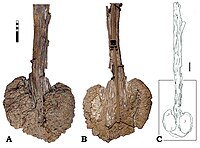 | |
Avialans[edit]
| Avialansof the Two Medicine Formation | ||||||
|---|---|---|---|---|---|---|
| Genus | Species | Location | Stratigraphic position | Material | Notes | Images |
| Gettyia[16][19] | G. gloriae[16] | Upper[16] | "Tarsometatarsus"[20] | Anavisauridenantiornithean | ||
Ceratopsians[edit]
| Ceratopsiansof the Two Medicine Formation | ||||||
|---|---|---|---|---|---|---|
| Genus | Species | Location | Stratigraphic position | Material | Notes | Images |
| Achelousaurus[16] | A. horneri[16] | Landslide Butte | Upper[16] | "[Three] partial skulls, [one] partial skeleton."[21] | Acentrosaurineceratopsid | 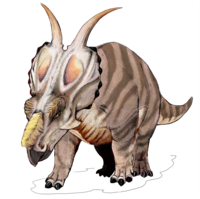 |
| Brachyceratops[16] | B. montanensis[16] | Upper[16] | "[Six] partial skulls, skeletons, subadult."[21] | A centrosaurine ceratopsid. Might be a juvenileStyracosaurus |  | |
| Cerasinops | C. hodgskissi | Lower[22] | Aleptoceratopsid |  | ||
| Einiosaurus[16] | E. procurvicornis[16] | Landslide Butte | Upper[16] | "[Three] adult skulls, juvenile and subadult cranial and postcranial elements."[21] | A centrosaurine ceratopsid | 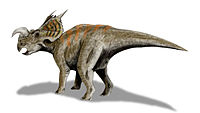 |
| Prenoceratops | P. pieganensis | Upper | A leptoceratopsid |  | ||
| Stellasaurus[23] | S. ancellae | Landslide Butte | Upper[16] | "Nasal horn and fragmentary parietal frill." | A centrosaurine ceratopsid |  |
| Styracosaurus[24] | S. ovatus | Fragmentary parietal frill. | A centrosaurine ceratopsid |  | ||
Non-avialan eumaniraptorans[edit]
| Non-avialaneumaniraptoransof the Two Medicine Formation | ||||||
|---|---|---|---|---|---|---|
| Genus | Species | Location | Stratigraphic position | Material | Notes | Images |
| Bambiraptor[16] | B. feinbergorum[16] | Upper[16] | "Almost complete skull and postcrania,"[25]type specimen | Asaurornitholestinedromaeosaur |  | |
| Dromaeosaurus[26] | Indeterminate[26] | Lower[26] |  | |||
| Richardoestesia[16] | Indeterminate[16] | Upper[16] | Teeth | |||
| Saurornitholestes[27] | Indeterminate[27] |
|
Partial skeleton, isolated pedal elements | A saurornitholestine dromaeosaur |  | |
| Troodontidae | Indeterminate | Upper | Partial skulls, several vertebrae, ribs, gastralia, chevrons, a sacrum, partial pelvis, and partial fore and hind limbs | Remains probably referable toStenonychosaurus.Formerly referred toTroodon,now a potentially dubious genus | ||
Ornithopods[edit]
An unidentifiedlambeosaurinehas been collected from the same stratigraphic placement, west of Bynum, and is in preparation at The Montana Dinosaur Center[28]
| Ornithopodsandparksosaursof the Two Medicine Formation | ||||||
|---|---|---|---|---|---|---|
| Genus | Species | Location | Stratigraphic position | Material | Notes | Images |
| Acristavus[29] | A. gagslarsoni | Lower | Asaurolophinehadrosaur | |||
| Glishades | G. ericksoni | Ahadrosauroid[30]or anindeterminatejuvenile saurolophine hadrosaur.[31] | ||||
| Gryposaurus[27] | G. latidens[26] | Two Medicine River |
|
"Several partial skulls and postcranial skeletons."[32]Also known from isolated teeth which may have been redeposited fossils, although this explanation is unlikely.[12] | A saurolophine hadrosaur. The isolatedG. latidensteeth are a rare component of channel lag deposits in the middle portion of the formation.[12] |  |
| Indeterminate[16] | Upper[16] | |||||
| Hypacrosaurus[16] | H. stebingeri[16] |
|
Upper[16] | A very abundant species oflambeosaurinehadrosaur.[33] |  | |
| Indeterminate | "Choteau/Bynum" | Upper | ||||
| Maiasaura[16] | M. peeblesorum[16] |
|
Upper[16] | "More than [two hundred] specimens including articulated skull and postcrania, embryo to adult."[32] | A saurolophine hadrosaur.ChoteauMaiasauraremains are found in higher strata than their Two Medicine River counterparts.[6]It is the most common dinosaur found in the Egg Mountain locality.[34] |  |
| Orodromeus[16] | O. makelai[16] | "Choteau/Bynum" | Upper[16] | Anorodrominethescelosaurwhich was the most common small herbivore in the Egg Mountain area.[35][36] |  | |
| Prosaurolophus[16] | P. maximus[16] |
|
Upper[16] | "Disarticulated, associated skull and postcrania pertaining to at least [four] individuals."[32] | A saurolophine hadrosaur.Prosaurolophus blackfeetensis,erected for Two Medicine fossils, is a synonym ofP. maximus.[37] | 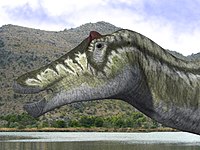 |
Oviraptorosaurs[edit]
The first find of an oviraptorosaur in Montana was anarticularregion from the lower jaw ofCaenagnathus sternbergi,from the Two Medicine Formation, according to a 2001 paper byDavid J. Varrichio.[38]This species had previously only been known from the Canadian province ofAlberta.[38]Varricchio observes that during the lateCampanian,Alberta and Montana had very similartheropodsdespite significant differences in the types of herbivorous dinosaur faunas.[38]
| Oviraptorosaursof the Two Medicine Formation | ||||||
|---|---|---|---|---|---|---|
| Genus | Species | Location | Stratigraphic position | Material | Notes | Images |
| Chirostenotes[39] | C. pergracilis[39] | Known from the articular region of a lower jaw, catalogued as MOR 1107[39] | Was previously referred toCaenagnathus sternbergi(a synonym ofChirostenotes) | |||
Tyrannosauroids[edit]
| Tyrannosauroidsof the Two Medicine Formation | ||||||
|---|---|---|---|---|---|---|
| Genus | Species | Location | Stratigraphic position | Material | Notes | Images |
| Daspletosaurus[16] | D. horneri[16] | Upper | Bonebed[40] |  | ||
| D. wilsoni | Upper | Bonebed[41] | More closely related toD. torosusand the Oldman/Dinosaur Park species thanD. horneri.[42] | |||
| Gorgosaurus | G. libratus? | "Choteau/Bynum" | Upper |  | ||
Color key
|
Notes Uncertain or tentative taxa are insmall text; |
Other fauna[edit]
Many other fossil animals have been found, such as freshwaterbivalves,gastropods,turtles,lizards such asMagnuviator,andchampsosaurs.The multituberculate mammalCimexomyshas been found on Egg Mountain. The speciesPiksi barbarulnawas described based on forelimb bones from the Two Medicine Formation; it was initially thought to be abird,but subsequently it was reinterpreted as apterosaur,likely a member ofOrnithocheiroidea.[43]Azhdarchoidpterosaurs are also known from the Two Medicine Formation, including a very large, yet-unnamedazhdarchid,the estimated wingspan of which was 8 metres (26 ft), and smallerMontanazhdarcho minor,a non-azhdarchid azhdarchoid.[44][45]Insectandmammalburrowshave also been discovered, as well as dinosaurcoprolites.
See also[edit]
- List of dinosaur-bearing rock formations
- List of fossil sites(with link directory)
References[edit]
- ^abcdefghi"Previous Work". Trexler (2001); page 300.
- ^"Introduction". Trexler (2001); pages 299-300.
- ^abcd"Introduction". Trexler (2001); page 299.
- ^"Introduction". Trexler (2001); pages 298-299.
- ^ab"Geological Setting". Trexler (2001); page 300.
- ^abc"Faunal Turnover, Migration, and Evolution". Trexler (2001); page 304.
- ^"Geological Setting". Trexler (2001); pages 300-301.
- ^abcdefg"Geological Setting". Trexler (2001); page 301.
- ^abcdefghijk"Geological Setting". Trexler (2001); page 302.
- ^abc"Abstract". Trexler (2001); page 298.
- ^abcdef"Faunal Turnover, Migration, and Evolution". Trexler (2001); page 306.
- ^abcdef"Two Medicine Fauna". Trexler (2001); page 303.
- ^Horner, J. R., Schmitt, J. G., Jackson, F., & Hanna, R. (2001). Bones and rocks of the Upper Cretaceous Two Medicine-Judith River clastic wedge complex, Montana. In Field trip guidebook, Society of Vertebrate Paleontology 61st Annual Meeting: Mesozoic and Cenozoic Paleontology in the Western Plains and Rocky Mountains. Museum of the Rockies Occasional Paper (Vol. 3, pp. 3-14).
- ^abc"Two Medicine Fauna". Trexler (2001); page 302.
- ^"Two Medicine Fauna". Trexler (2001); pages 302-303.
- ^abcdefghijklmnopqrstuvwxyzaaabacadaeafagahaiajakalamanaoap"3.11 Montana, United States; 6. Upper Two Medicine Formation". in Weishampel,et al.(2004). Page 583.
- ^abcdPenkalski, P. (2013)."A new ankylosaurid from the late Cretaceous Two Medicine Formation of Montana, USA".Acta Palaeontologica Polonica.59(3): 617–634.doi:10.4202/app.2012.0125.
- ^abcArbour, Victoria M.; Currie, Philip J. (8 May 2013)."Euoplocephalus tutus and the Diversity of Ankylosaurid Dinosaurs in the Late Cretaceous of Alberta, Canada, and Montana, USA".PLOS ONE.8(5): e62421.Bibcode:2013PLoSO...862421A.doi:10.1371/journal.pone.0062421.PMC3648582.PMID23690940.
- ^Atterholt, Jessie; Hutchison, J. Howard; O’Connor, Jingmai K. (2018)."The most complete enantiornithine from North America and a phylogenetic analysis of the Avisauridae".PeerJ.6:e5910.doi:10.7717/peerj.5910.PMC6238772.PMID30479894.
- ^"Table 11.1". in Weishampel,et al.(2004). Page 212.
- ^abc"Table 23.1". in Weishampel,et al.(2004). Page 495.
- ^Chinnery, Brenda J.; Horner, John R. (2007). "A New Neoceratopsian Dinosaur Linking North American and Asian Taxa".Journal of Vertebrate Paleontology.27(3): 625–641.doi:10.1671/0272-4634(2007)27[625:anndln]2.0.co;2.S2CID86091277.
- ^Wilson, John P.; Ryan, Michael J.; Evans, David C. (2020)."A new, transitional centrosaurine ceratopsid from the Upper Cretaceous Two Medicine Formation of Montana and the evolution of the 'Styracosaurus-line' dinosaurs".Royal Society Open Science.7(4): 200284.Bibcode:2020RSOS....700284W.doi:10.1098/rsos.200284.PMC7211873.PMID32431910.
- ^Holmes, R.B.; Persons, W.S.; Singh Rupal, B.; Jawad Qureshi, A.; Currie, P.J. (2020). "Morphological variation and asymmetrical development in the skull ofStyracosaurus albertensis".Cretaceous Research.107:104308.Bibcode:2020CrRes.10704308H.doi:10.1016/j.cretres.2019.104308.S2CID210260909.
- ^"Table 10.1". in Weishampel,et al.(2004). Page 198.
- ^abcdef"3.11 Montana, United States; 2. Lower Two Medicine Formation". in Weishampel,et al.(2004). Pages 582-583.
- ^abc"3.11 Montana, United States; 2. Lower Two Medicine Formation" and "3.11 Montana, United States; 6. Upper Two Medicine Formation". in Weishampel,et al.(2004). Pages 582-583.
- ^"Two Medicine Fauna". Trexler (2001); page 304.
- ^Gates, T.A.; Horner, J.R.; Hanna, R.R.; Nelson, C.R. (2011). "New unadorned hadrosaurine hadrosaurid (Dinosauria, Ornithopoda) from the Campanian of North America".Journal of Vertebrate Paleontology.31(4): 798–811.Bibcode:2011JVPal..31..798G.doi:10.1080/02724634.2011.577854.S2CID8878474.
- ^Prieto-Márquez, Albert (2010)."Glishades ericksoni,a new hadrosauroid (Dinosauria: Ornithopoda) from the Late Cretaceous of North America "(PDF).Zootaxa.2452:1–17.doi:10.11646/zootaxa.2452.1.1.
- ^Campione, Nicolás E.; Brink, Kirstin S.; Freedman, Elizabeth A.; McGarrity, Christopher T.; Evans, David C. (2012). "Glishades ericksoni,an indeterminate juvenile hadrosaurid from the Two Medicine Formation of Montana: implications for hadrosauroid diversity in the latest Cretaceous (Campanian-Maastrichtian) of western North America ".Palaeobiodiversity and Palaeoenvironments.93(1): 65–75.doi:10.1007/s12549-012-0097-1.S2CID128568454.
- ^abc"Table 20.1". in Weishampel,et al.(2004). Page 440.
- ^Varricchio, David J. (April 1995)."Taphonomy of Jack's Birthday Site, a diverse dinosaur bonebed from the Upper Cretaceous Two Medicine Formation of Montana".Palaeogeography, Palaeoclimatology, Palaeoecology.114(2–4): 297–323.Bibcode:1995PPP...114..297V.doi:10.1016/0031-0182(94)00084-l.ISSN0031-0182.
- ^Dawson, John."Egg Mountain, the Two Medicine, and the Caring Mother Dinosaur".National Park Service.U. S. Department of the Interior.Retrieved20 March2021.
- ^Hirsch, Karl F.; Quinn, Betty (1990)."Eggs and eggshell fragments from the Upper Cretaceous Two Medicine Formation of Montana".Journal of Vertebrate Paleontology.10(4): 491–511.Bibcode:1990JVPal..10..491H.doi:10.1080/02724634.1990.10011832.Retrieved25 April2021.
- ^Horner, John R.; Weishampel, David B. (March 17, 1998)."A comparative embryological study of two ornithischian dinosaurs".Nature.332(6161): 256–257.doi:10.1038/332256a0.S2CID4329316.Retrieved25 April2021.
- ^McGarrity, C. T.; Campione, N. E.; Evans, D. C. (2013)."Cranial anatomy and variation inProsaurolophus maximus(Dinosauria: Hadrosauridae) ".Zoological Journal of the Linnean Society.167(4): 531–568.doi:10.1111/zoj.12009.
- ^abc"Abstract". Varricchio (2001); page 42.
- ^abc"Table 5.1". in Varricchio (2001). Page 44.
- ^Carr, Thomas D.; Varricchio, David J.; Sedlmayr, Jayc C.; Roberts, Eric M.; Moore, Jason R. (30 March 2017)."A new tyrannosaur with evidence for anagenesis and crocodile-like facial sensory system".Scientific Reports.7:44942.Bibcode:2017NatSR...744942C.doi:10.1038/srep44942.PMC5372470.PMID28358353.
- ^Currie, Trexler, Koppelhus, Wicks and Murphy (2005). "An unusual multi-individual tyrannosaurid bonebed in the Two Medicine Formation (Late Cretaceous, Campanian) of Montana (USA)." P.p. 313-324 in Carpenter, K. (ed.),The Carnivorous Dinosaurs. III. Theropods as living animals.
- ^"Tyrannosauroidea".www.theropoddatabase.com.Retrieved2020-11-06.
- ^Agnolin, Federico L.; Varricchio, David (2012)."Systematic reinterpretation ofPiksi barbarulnaVarricchio, 2002 from the Two Medicine Formation (Upper Cretaceous) of Western USA (Montana) as a pterosaur rather than a bird "(PDF).Geodiversitas.34(4): 883–894.doi:10.5252/g2012n4a10.S2CID56002643.
- ^Naish, Darren (January 30, 2013)."A new azhdarchid pterosaur: the view from Europe becomes ever more interesting".Tetrapod Zoology.RetrievedFebruary 6,2013.
- ^Carroll, N. (2015). "Reassignment ofMontanazhdarcho minoras a non-azhdarchid member of the Azhdarchoidea ".Journal of Vertebrate Paleontology, Programs and Abstracts.104.
Bibliography[edit]
- Dodson, P., C.A. Forster, and S.D. Sampson. 2004. Ceratopsidae in Weishampel, D.B., P. Dodson, and H. Osmolska (eds.)The Dinosauria.2nd Edition, University of California Press.
- Rogers, R.R. (1990). "Taphonomy of three dinosaur bone beds in the Upper Cretaceous Two Medicine Formation of northwestern Montana: evidence for drought-related mortality".PALAIOS.5(5): 394–413.Bibcode:1990Palai...5..394R.doi:10.2307/3514834.JSTOR3514834.
- Trexler, D., 2001, Two Medicine Formation, Montana: geology and fauna: In:Mesozoic Vertebrate Life,edited by Tanke, D. H., and Carpenter, K., Indiana University Press, pp. 298–309.
- Varricchio, D.J. (1995)."Taphonomy of Jack's Birthday Site, a diverse dinosaur bonebed from the Upper Cretaceous Two Medicine Formation of Montana"(PDF).Palaeogeography, Palaeoclimatology, Palaeoecology.114(2–4): 297–323.Bibcode:1995PPP...114..297V.doi:10.1016/0031-0182(94)00084-l.
- Varricchio, D. J. 2001. Late Cretaceous oviraptorosaur (Theropoda) dinosaurs from Montana. pp. 42–57 in D. H. Tanke and K. Carpenter (eds.), Mesozoic Vertebrate Life. Indiana University Press, Indianapolis.
- Weishampel,David B.;Dodson,Peter;Osmólska,Halszka, eds. (2004).The Dinosauria, 2nd edition.Berkeley: University of California Press. pp. 1–880.ISBN0-520-24209-2.Retrieved2019-02-21.
- Geologic formations of Alberta
- Geologic formations of Montana
- Upper Cretaceous Series of North America
- Cretaceous Alberta
- Cretaceous Montana
- Campanian Stage
- Sandstone formations of Canada
- Sandstone formations of the United States
- Fluvial deposits
- Deltaic deposits
- Ichnofossiliferous formations
- Ooliferous formations
- Fossiliferous stratigraphic units of North America
- Paleontology in Alberta
- Paleontology in Montana
- Glacier National Park (U.S.)


